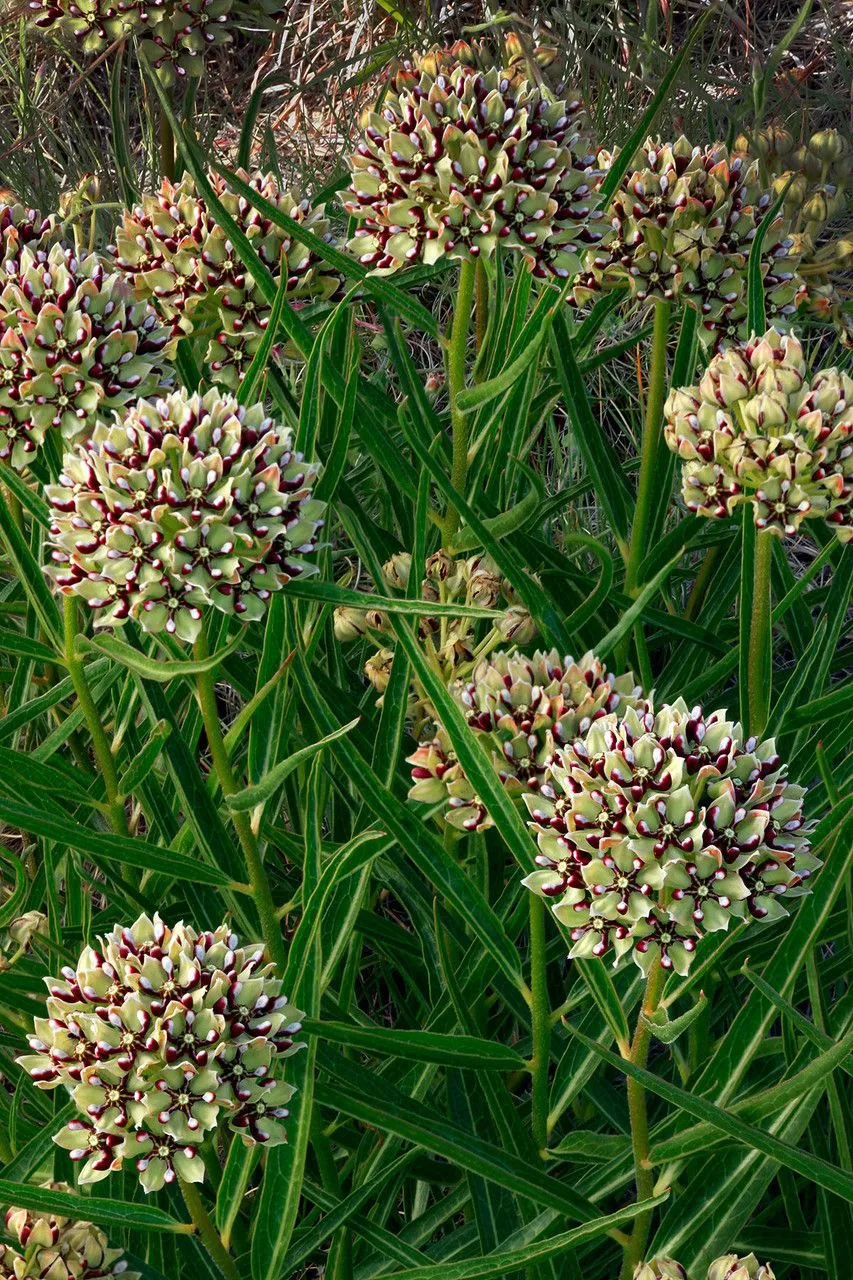
Author: (Decne.) Woodson
Bibliography: Ann. Missouri Bot. Gard. 61: 193 (1954)
Year: 1954
Status: accepted
Rank: species
Genus: Asclepias
Vegetable: False
Observations: W. & C. U.S.A. to N. Mexico
Antelope horns, scientifically known as Asclepias asperula, is a celebrated member of the Apocynaceae family. This perennial plant is primarily recognized for its unique and striking appearance, which plays an integral role in the ecosystems of western and central United States extending down to northern Mexico.
One of the notable features of Antelope horns is its distinctive flowers. The plant gets its common name from the appearance of its seed pods, which resemble the horns of an antelope. These flowers are typically pale green to delicate shades of purple, forming in dense clusters that emerge from the center of the plant. The blossoms usually appear in late spring to early summer, offering a striking visual contrast against the arid landscapes they commonly inhabit.
Antelope horns is particularly adapted to survive in arid conditions, thriving in well-drained soils and full sunlight. The leaves of Asclepias asperula are narrow and elongated, showing a silvery-gray hue which helps reduce water loss—a vital adaptation for survival in the dry, often hot climates where it is found.
Ecologically, Antelope horns is invaluable. It serves as a crucial host plant for the larvae of the Monarch butterfly (Danaus plexippus), providing both a food source and a habitat. Adult butterflies sip nectar from the intricate flowers, making Asclepias asperula an essential component in maintaining butterfly populations and promoting biodiversity. Furthermore, the nectar of Antelope horns also attracts a variety of other pollinators, including bees and hummingbirds, thereby supporting broader ecological interactions.
The cultural and scientific significance of Antelope horns was documented in the Annals of the Missouri Botanical Garden in 1954 by the botanist Woodson. This documentation highlighted not only the plant’s botanical characteristics but also its geographical distribution and ecological relationships.
Through the lens of conservation, Antelope horns is particularly important. As the habitats of pollinators like the Monarch butterfly face increasing threats from human activity and climate change, preserving and understanding plants such as Asclepias asperula becomes ever more critical. These plants are not only vital for the health of pollinator species but also for the overall health of the ecosystems they support.
In cultivating Antelope horns, gardeners and conservationists should replicate its natural environment as closely as possible, emphasizing well-drained soils and plenty of sunlight. Its resilience and ecological benefits make it a not only a striking plant for natural landscapes but also a pivotal species in efforts to sustain pollinator populations and biodiversity.
Eng: antelope horns, antelopehorn milkweed, immortal, spider antelope-horns, spider milkweed
En: Antelope horns, Immortal, Spider milkweed, Antelopehorn milkweed, Spider antelope-horns
Zh: 蜘蛛乳草
Fi: Sarvisilkkiyrtti
Nv: Jádí yildeeʼí
Zh-tw: 蜘蛛乳草
Taken Apr 17, 2021 by Cerina Cerina Bee (cc-by-sa)
Taken Apr 19, 2022 by Sharon Walker (cc-by-sa)
Taken Dec 19, 2021 by selber pflanzen (cc-by-sa)
Taken Apr 11, 2021 by bowdenjeffery (cc-by-sa)
Taken Jul 11, 2019 by Slis (cc-by-sa)
Taken Mar 25, 2016 by EOL − John (cc-by-nc)
Taken Mar 25, 2016 by EOL − John (cc-by-nc)
Taken Dec 13, 2015 by EOL − clickinon (cc-by-nc)
Taken Mar 24, 2016 by EOL − Ridlon Kiphart (cc-by-nc)
Taken Apr 20, 2021 by Cerina Cerina Bee (cc-by-sa)
Taken Feb 15, 2014 by EOL − Richard Reynolds (cc-by-nc)
Taken Mar 6, 2016 by EOL − Ridlon Kiphart (cc-by-nc)
Taken Mar 5, 2016 by EOL − Ridlon Kiphart (cc-by-nc)
Taken Mar 5, 2016 by EOL − Ridlon Kiphart (cc-by-nc)
Taken Dec 2, 2015 by EOL − ellen hildebrandt (cc-by-nc)
Taken Dec 5, 2013 by EOL − Brenda Hoffman (cc-by-nc)
Taken May 16, 2014 by EOL − Linda Jo Conn (cc-by-nc)
Taken Apr 26, 2005 by EOL − David Bygott (cc-by-nc-sa)
Taken Jun 14, 2014 by EOL − Wynn Anderson (cc-by-nc-sa)
Taken Jun 14, 2014 by EOL − Wynn Anderson (cc-by-nc-sa)
Taken Jul 12, 2015 by EOL − jeandotson (cc-by-nc)
© copyright of the Board of Trustees of the Royal Botanic Gardens, Kew.
Growth habit: Forb/herb
Family: Myrtaceae Author: (F.Muell.) K.D.Hill & L.A.S.Johnson Bibliography: Telopea 6: 402 (1995) Year: 1995 Status:…
Family: Rubiaceae Author: Pierre ex A.Froehner Bibliography: Notizbl. Bot. Gart. Berlin-Dahlem 1: 237 (1897) Year:…
Family: Sapindaceae Author: Koidz. Bibliography: J. Coll. Sci. Imp. Univ. Tokyo 32(1): 38 (1911) Year:…
Family: Asteraceae Author: A.Gray Bibliography: Pacif. Railr. Rep.: 107 (1857) Year: 1857 Status: accepted Rank:…
Family: Fabaceae Author: Medik. Bibliography: Vorles. Churpfälz. Phys.-Ökon. Ges. 2: 398 (1787) Year: 1787 Status:…
Family: Aspleniaceae Author: (Cav.) Alston Bibliography: Bull. Misc. Inform. Kew 1932: 309 (1932) Year: 1932…